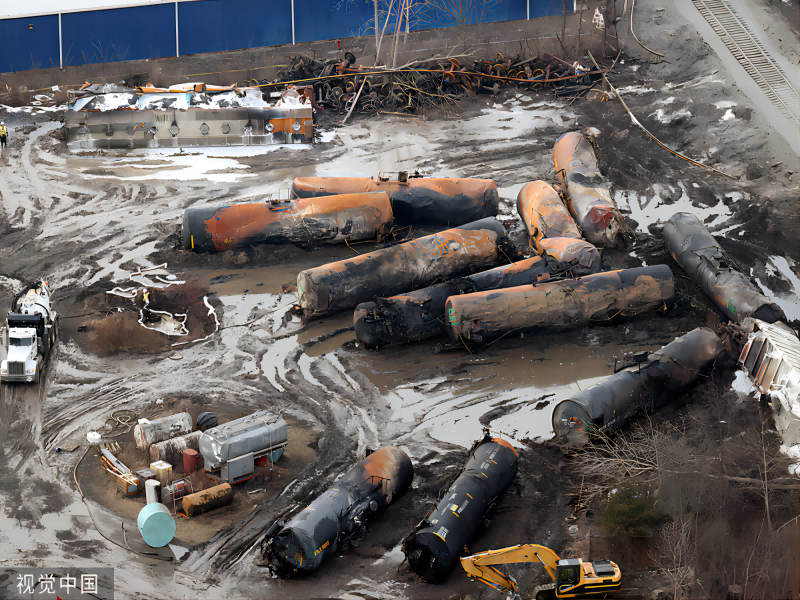Foreign trade industry news
A toxic gas leak caused by a train derailment in Ohio, the United States, is spreading on the Internet.
What exactly is the vinyl chloride leaking from the train derailment? What are the possible hazards of vinyl chloride to human health and the surrounding environment? How to scientifically and safely dispose of dangerous chemicals such as vinyl chloride? Science and Technology Daily reporter interviewed relevant people.
It has serious harm to human body and environment
"Vinyl chloride, also called vinyl chloride, has the chemical formula C_2H_3Cl." "At normal temperature and pressure, vinyl chloride is a colorless odor gas, its density is less than water but greater than air, and it can be changed into a liquid state after pressure condensation treatment," said Xiu Furong, professor of geology and Environment College of Xi 'an University of Science and Technology.
The vinyl chloride leaked from the train derailment was not a gas, but a liquid. This may be related to the higher density of vinyl chloride in the liquid state after pressure condensation treatment, and more vinyl chloride can be transported per car. "Vinyl chloride is highly flammable and explosive." Xiu Furong pointed out. When vinyl chloride is mixed with air, its explosion limit is 4%-21%, and it is more explosive after pressure treatment.
Hazardous chemicals refer to highly toxic chemicals and other chemicals that are toxic, corrosive, explosive, combustible and combustive and that are harmful to human body, facilities and the environment. "Vinyl chloride is a typical dangerous chemical, if a large amount of leakage, will cause serious harm to human health and the surrounding environment." Xiu Furong pointed out.
If inhaled or exposed to the skin in large quantities, vinyl chloride will produce very serious carcinogenic and toxic effects on the human body. "Vinyl chloride is a group 1 carcinogen, mainly toxic or damaging to the nervous system, liver, digestive system and skin." Xiu Furong introduced.
The toxicity of vinyl chloride can be divided into acute poisoning, chronic poisoning and skin contact poisoning. In acute poisoning, mild intoxication often presents dizziness, chest tightness, drowsiness and so on. Severe poisoning results in coma, convulsions, and even death. Chronic poisoning, the victim will appear neurasthenia, liver function damage, digestive function damage and other symptoms. Skin contact poisoning, often lead to intoxication erythema, eczema, edema and even limb necrosis.
"Vinyl chloride leaks into the air in large quantities, potentially causing irreversible damage to the surrounding environment." Xiu Furong pointed out. Vinyl chloride, because of its density than air, often diffuses at low places, and its influence is larger; Vinyl chloride is easy to mix with air to form flammable and explosive mixture, which is easy to explode in case of heat source or open flame; Vinyl chloride dispersing into the atmosphere can participate in the reaction and formation of photochemical smog, contributing to air pollution. In addition, due to its severe toxicity, vinyl chloride can also cause serious damage to the ecological environment, causing a large number of animals and plants to die, thus affecting biodiversity.
Scientific handling to avoid possible risks
The leakage of hazardous chemicals in the United States has sounded the alarm for the disposal of hazardous chemicals in our country. How should we learn from this to scientifically and safely dispose of dangerous chemicals such as vinyl chloride to prevent similar accidents from happening in our country?
"Generally speaking, we have to follow the country's Hazardous Chemical Safety Regulations and dispose of various hazardous chemicals." "Specifically, relevant safety regulations should be followed in the production, operation, storage, transportation and disposal processes to avoid possible risks caused by dangerous chemicals to the greatest extent," Xiu said.
In the production operation link, to adhere to closed operation, do a good job of safe ventilation. Operators should wear gas masks, safety protective glasses, chemical protective clothing and gloves; Operating places should be away from fire and heat sources, explosion-proof installation, ventilation system and equipment.
In the storage and transportation link, all kinds of dangerous chemicals should be stored in a cool and ventilated warehouse during storage; During transportation, assembly and transportation shall be carried out in accordance with the relevant regulations on the transportation of hazardous chemicals, away from fire and heat sources, separate from oxidants, and prevent sunlight exposure.
In the process of waste disposal, scientific disposal should be carried out according to the characteristics of different dangerous chemicals. "After vinyl chloride is discarded, it is generally disposed of by incineration." Xiu Furong said.
It should be pointed out in particular that in the incineration process of chlorinated plastics such as vinyl chloride, if the incineration temperature is below 800℃, it will cause incomplete combustion and easily generate chlorobenzene, the precursor of the synthesis of highly toxic substances dioxins. "Therefore, we need to use professional incinerators in professional hazardous waste incineration institutions to dispose of chloroethylene and other chlorine-containing substances, and strictly deal with the exhaust gas produced after incineration. They can only be released when they meet national emission standards." Xiu Furong said.





